
May/June 2016
Hyperkyphosis: A New Geriatric Syndrome Geriatrician and epidemiologist Diane L. Schneider, MD, MSc, gathers information and insight on hyperkyphosis from Deborah Kado, MD, MS, who has focused 20 years of research on the thoracic spine curvature that often goes undiagnosed and untreated. Kyphosis is the normal concave curvature of the thoracic spine. Although kyphosis is commonly the term used for the pathologic condition of forward stooped posture or "dowager's hump," hyperkyphosis is the correct description. Geriatric syndrome is a problem that usually has more than one cause and involves many parts of the body. The term "geriatric syndrome" is used to capture those clinical conditions in older individuals that do not fit into discrete disease categories. Many of the most common conditions cared for by geriatricians, such as delirium, falls, and frailty, are classified as geriatric syndromes. Deborah Kado, MD, MS, a geriatrician, director of the osteoporosis clinic at the University of California, San Diego (UCSD) Hospitals, and a professor of medicine at UCSD, is one of the few researchers who study hyperkyphosis. For 20 years, hyperkyphosis has been the focus of her research activities. She recently sat down with Today's Geriatric Medicine's Editorial Board Advisor Diane L. Schneider, MD, MSc, to provide insights on why clinicians should recognize, document, and treat hyperkyphosis. DS: How do you define hyperkyphosis? DS: How did you become interested in this area? Then the question became: Why are these women with vertebral fractures dying? One of the hypotheses was that death occurred from becoming hunched over. So that's how my investigation started, and here I am 20 years later still studying the same thing. DS: Why do you think hyperkyphosis is underreported and not a diagnosis included on the problem list? DS: Why is it important to identify hyperkyphosis in patients? For our patients, hyperkyphosis is bothersome. They don't like becoming progressively hunched over. In our osteoporosis clinic, we see many women who seek medical advice because they don't want the condition to worsen as they get older. So fracture prevention is one important aspect. Some women come in because they saw their mothers get hunched over, and they don't want the same thing to happen to them. Therefore, screening for low bone density in patients with family history is important. Height loss and progressive postural slumping might provide clues to underlying vertebral fractures and trigger the clinician to do an osteoporosis work-up that includes bone density assessment by DXA [dual-energy X-ray absorptiometry] and radiographic imaging of the spine. If the patient has vertebral fractures or low bone density, treatment for osteoporosis is indicated. Studies in the last five years have demonstrated that women and men with low bone density and vertebral fractures are much more likely to experience kyphosis progression. However, only about one-third of patients with hyperkyphosis have underlying vertebral fractures. DS: What's accounting for the two-thirds of patients with hyperkyphosis who don't have vertebral fractures? DS: Besides evaluating for osteoporosis, why should clinicians be concerned? DS: What are the consequences of hyperkyphosis? Both men and women showed evidence of declining lung function over time. The presence of vertebral fractures predicted future nonspine fractures. And severe hyperkyphosis is associated with gastrointestinal problems, including [gastroesophageal reflux disorder] and dysphagia. DS: What can be done to improve hyperkyphosis? Fall prevention is another expected treatment outcome but has not been formally studied yet in randomized controlled trials. Treating osteoporosis, if it exists, is important to decrease the risk of vertebral fractures. Once one vertebral fracture has occurred, the risk of subsequent vertebral fractures is high. DS: Is there a difference between genders in hyperkyphosis? Evaluation of sex hormones has shown some interesting results. In an analysis of the Study of Osteoporotic Fractures, over a 15-year period, estrogen users, current or past, had more upright posture and less hyperkyphosis than never users. In the MrOS [The Osteoporotic Fractures in Men] study, men with lower estradiol levels had the highest angles of kyphosis. Higher [sex hormone-binding globulin] levels were also predictive of a higher degree of curvature. These findings suggest that estrogen is somehow a factor. The role of sex hormones in the underlying etiology is under investigation. In a small study published in the Journal of Bone and Mineral Research in November 2015, estrogen and marrow fat changes in vertebral bodies suggested that estradiol regulates bone marrow fat independent of bone mass. Perhaps estrogen has a direct effect to prevent gradual anterior vertebral wedging. DS: How can clinicians evaluate their patients for hyperkyphosis? The easiest way to quantitate kyphosis is to have a patient stand against the wall. Measure the occiput-to-wall distance. Because of fall risk, I also assess balance with tandem and semitandem stand. DS: What do you recommend to your patients with hyperkyphosis? There are some new high-tech postural reminder devices, but these may not be readily adopted by older patients. I consider referral to physical therapy. And I counsel patients on avoiding extreme spinal flexion and twisting. Despite significant findings regarding its adverse effects on measures of health and quality of life, hyperkyphosis is only beginning to be recognized by clinicians as a major health concern. — Diane L. Schneider, MD, MSc, is a geriatrician and epidemiologist, a former associate professor of medicine, the author of The Complete Book of Bone Health, and cofounder of 4BoneHealth. |
